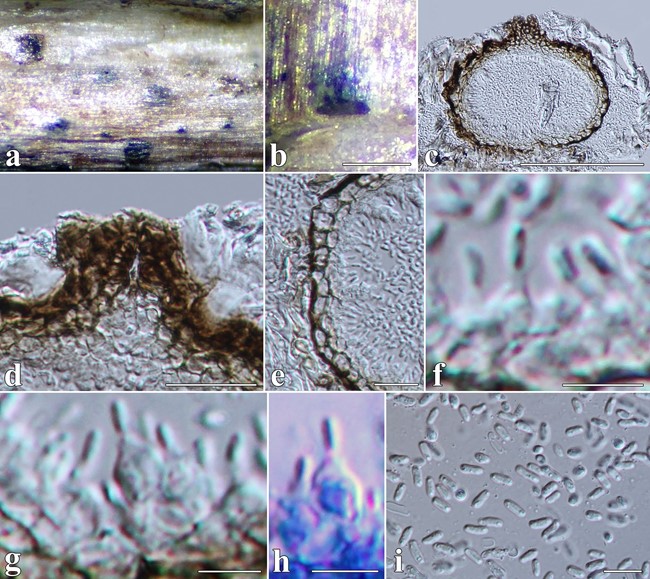Anthodidymella ranunculacearum Phukhams., Camporesi & K.D. Hyde, sp. nov.
MycoBank number: MB 557130; Index Fungorum number: IF 557130; Facesoffungi number: FoF 07257, Fig. 13.
Etymology: The specific epithet reflects the host family, Ranunculaceae.
Holotype: MFLU 17–1468.
Saprobic on dead stems of Clematis vitalba. Sexual morph: Undetermined. Asexual morph: Conidiomata 99–214 × 130–246 μm (x̄= 142 × 169 μm, n = 5), pycnidial, solitary, sometimes aggregated, uniloculate, immersed under epidermal layer, subglobose to depressed, coriaceous,thin-walled, brown to dark brown, with ostiolate. Ostioles 25 × 42 μm, central, papillate, with pore. Conidiomatal wall 10–28(–36) μm wide, of 2–5 layers, each cell-layer 10 μm wide, light brown to brown cells of textura globu- losa, heavily pigmented in the outer layers, lined with a hyaline innermost layer bearing conidiogenous cells. Con- idiophores reduced to conidiogenous cells. Conidiogenous cells 2.5–5 × 1.5–3.5 μm (x̄ = 3.5 × 2 μm, n = 30), phialidic, determinate, discrete, ampulliform, cylindrical to sub-cylin- drical, smooth-walled, hyaline, arising from the inner layer of conidioma. Conidia 6–10 × 2–5 μm (x̄ = 6 × 4 μm, n = 50), oblong or oval, slightly curved toward the ends, rounded ends, with 1(–2) guttules in each cell, hyaline, aseptate, smooth-walled.
Culture characters: Colonies on MEA reaching 20 mm diam. after 2 weeks at 25 °C. Cultures; above: greyish brown or dark green, dense, circular, umbonate, papillate, fluffy, covered with aerial mycelium, reverse dark brown.
Material examined: Italy, Forlì-Cesena Province, Val- dinoce—Meldola, on dead aerial branch of Clematis vitalba, 3 February 2015, E. Camporesi, IT 2364 (MFLU 17–1536, holotype); ex-type living culture, MFLUCC 17–2184 = MFLUCC 17–2209.
Host: Clematis vitalba—(This study).
Distribution: Italy—(This study).
GenBank accession numbers: MFLUCC 17–2184; LSU: MT214550; SSU: MT226668; ITS: MT310597; tef1: MT394731; rpb2: MT394681; act: MT394620. MFLUCC 17–2209; LSU: MT214551; SSU: MT226669; ITS: MT310598; tef1: MT394732; act: MT394621.
Notes: Anthodidymella ranunculacearum (MFLUCC 17–2184) is similar to A. vitalbina (CBS 123707, ex-epi- type), a strain recorded from the same host (Woudenberg et al. 2009). However, A. ranunculacearum differs from A. vitalbina in its thicker conidiomatal wall (10–36 vs 5.5–9.5 μm, Fig. 13). In a BLASTn search of GenBank, the ITS sequence had 99.5% similarity (2.25% nucleotide differences), while the act sequence had 91% similarity (77 nucleotide differences in 297 nucleotides). Thus, the new strain is introduced as a new species of Anthodidymella based on guidelines of Jeewon and Hyde (2016). Addition- ally, A. ranunculacearum is designated as the type species of Anthodidymella based on available material and an ex-type culture.

Fig. 13 Anthodidymella ranunculacearum (MFLU 17–1468, holo- type). a Appearance of conidiomata on Clematis vitalba. b Close up of conidioma on host substrate. c Vertical section through conidi- oma. d Ostiolar canal. e Section of partial conidioma wall. f–h Con-idiogenous cells and conidia (h conidiogenous cells in cotton blue). i Conidia. Scale bars: b = 200 µm, c = 100 µm, d = 20 µm, e = 10 µm, f–i = 5 µm
